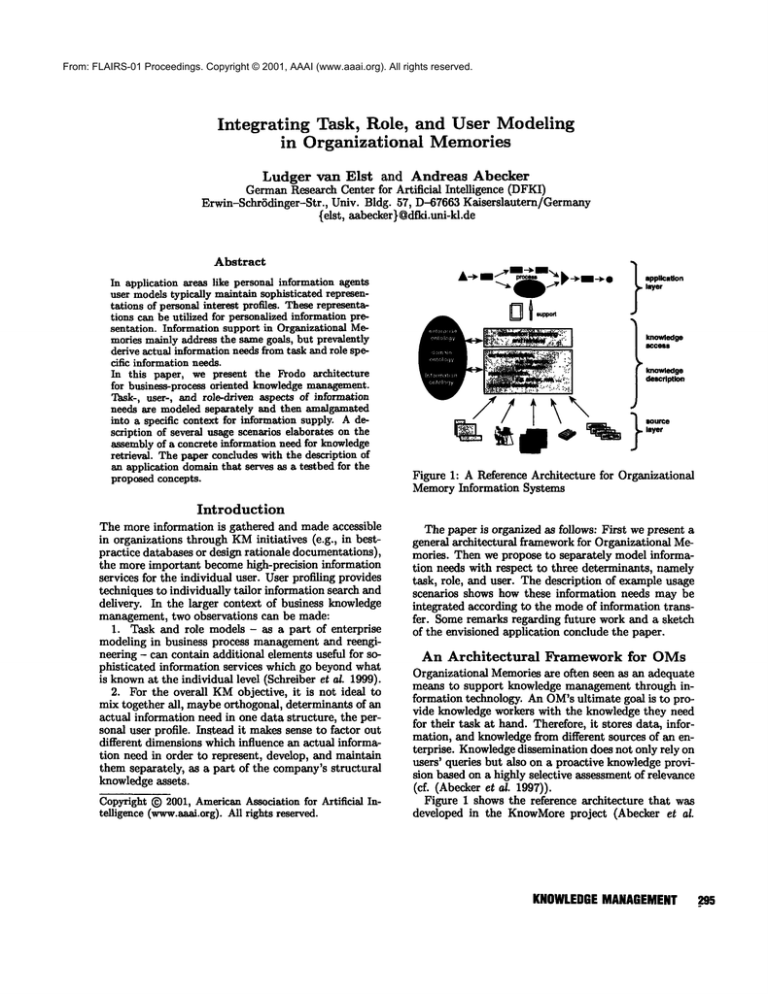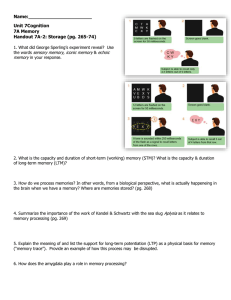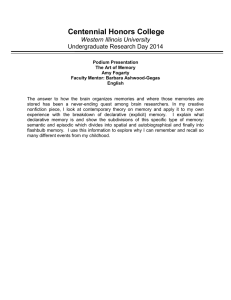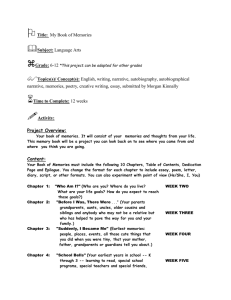
From: FLAIRS-01 Proceedings. Copyright © 2001, AAAI (www.aaai.org). All rights reserved.
Integrating
Task, Role,
in Organizational
and User Modeling
Memories
Ludgervan Elst and AndreasAbecker
GermanResearch
Centerfor Artificial
Intelligence
(DFKI)
Erwin-SchrGdinger-Str.,
Univ.Bldg.57, D-67663Kaiserslautern/Germany
{elst,
aabecker
} @dfld.uni-kl.de
Abstract
In application areas like personal information agents
user models typically maintain sophisticated representations of personal interest profiles. These representations can be utilized for personalized information presentation. Information support in Organizational Memories mainly address the same goals, but prevalently
derive actual information needs from task and role specific information needs.
In this paper, we present the Frodo architecture
for business-process oriented knowledge management.
Task-, user-, and role-driven aspects of information
needs are modeled separately and then amalgamated
into a specific context for information supply. A description of several usage scenarios elaborates on the
assembly of a concrete information need for knowledge
retrieval. The paper concludes with the description of
an application domainthat serves as a testbed for the
proposed concepts.
Imowieclge
description
FigureI: A Reference
Architecture
for Organizational
MemoryInformationSystems
Introduction
The more information is gathered and made accessible
in organizations through KMinitiatives (e.g., in bestpractice databases or design rationale documentations),
the more important become high-precision information
services for the individual user. User profiling provides
techniques to individually tailor information search and
delivery. In the larger context of business knowledge
management, two observations can be made:
1. Task and role models - as a part of enterprise
modeling in business process management and reengineering - can contain additional elements useful for sophisticated information services which go beyond what
is knownat the individual level (Schreiber et al. 1999).
2. For the overall KMobjective, it is not ideal to
mix together all, maybe orthogonal, determinants of an
actual information need in one data structure, the personal user profile. Instead it makes sense to factor out
different dimensions which influence an actual information need in order to represent, develop, and maintain
them separately, as a part of the company’s structural
knowledge assets.
Copyright
~) 2001,American
Association
forAxtificial
Intelligence
(www.~i.org).
Allrights
reserved.
Thepaperis organized
as follows:
Firstwe present
a
general
architectural
framework
forOrganizational
Memories.Thenwe proposeto separately
modelinformationneedswithrespectto threedeterminants,
namely
task,role,and user.Thedescription
of exampleusage
scenarios
showshow theseinformation
needsmay be
integrated
according
to themodeof information
transfer.Some remarksregarding
futurework and a sketch
of theenvisioned
application
conclude
thepaper.
An Architectural
Frameworkfor OMs
Organizational
Memories
are oftenseenas an adequate
meansto supportknowledgemanagementthroughinformation
technology.
An OM’sultimate
goalis to provide knowledge
workerswiththe knowledge
they need
fortheirtaskathand.Therefore,
it stores
data,information,
andknowledge
fromdifferent
sources
of an enterprise.
Knowledge
dissemination
doesnot onlyrelyon
users’queries
butalsoon a proactive
knowledge
provisionbasedon a highlyselective
assessment
of relevance
(cf. (Abecker et al. 1997)).
Figure 1 shows the reference architecture
that was
developed in the KnowMoreproject (Abecker et al.
KNOWLEDGE
MANAGEMENT
.295
2000b)
foran OMwithproactive
information
services.
butintroduced
separately
in several
departments
and
Itconsists
ofa source
layerthatcontains
information mustthenbe integrated.
Furthermore,
an OM’senobjects,
e.g.textsin a document
management
system,
vironment
maychange
dueto reorganizations
of an
best-practice
andlessons-learned
archives,
yellow
pages
enterprize’s
structure.
aboutexpertises
andcapabilities
etc.TheseinformaIntheremainder
of thispaperwe sketch
themodetionobjects
withtheirvarious
formats
anddegrees
of
ling
of
information
needs
in
Frodo
which
is
based
on a
formalization are integrated by uniform knowledgedeseparation
of
task-,
role-,
and
user-triggered
aspects.
scriptions. These knowledgedescriptions are formed
Thenwedescribe
a couple
ofusagescenarios
thatshow
by linking the information objects to formal structuhow
these
aspects
can
be
integrated
in
different
ways,
res (ontologies). KnowMore
deployed i) inf ormation
depending
on
the
mode
of
information
transfer
in
the
ontology, describing structural properties of information
OM.
objects (format, author, etc.), ii) enterprise ontology
representing the organizational structure (departments,
Modeling of Information Needs
roles, etc.), and iii) domain ontology for modeling the
content of information objects.
in Frodo
Theseknowledgedescriptions are utilized for knowledge
Inthissection,
webriefly
present
themainconstituents
access by information processing and retrieval services
of
our
approach
for
modeling
information
needsin aa
that present relevant information to the user. These
a modular
basisforhigh-performance
services
mayextensively
usetheknowledge
description OM to provide
services.
levelforconcept-based
retrieval
withdomain-specificinformation
Similar
toconventional
worldlow
systems,
tasks(in
strategies
(e.g.tofindemployees
withcertain
compebusiness
processes),
organizational
roles,
andindividual
tencies
(Liao
etal.1999)).
usersaretheprimaryelements.
Nowwe propose
to
Theusers’
information
needsaremodeled
at theapplianinformation
needdescription
(or,a profile)
cation
layer.
IntheKnowMore
approach
a conventional attach
toeachofthese
elements
(seeforfigure
2):
Work-flow
Management
System(WfMS)is proposed
1.A taskis described
bytheinformation
andknowthebasis
forthislayer.
Thetraditional
workfiow
model
isenriched
intwoways:
ledgerequired
to perform
it ("Inorderto configure
youneedcomponent
knowledge
as des1.Task-specific
generic
queries
define
theinformation theseproducts
cribed
in
the
product
data
sheets
and
catalogues,
you
need.
Essentially,
theontologies
oftheknowledge
demight need advice about procedures and strategies as
scription
layer
provide
thevocabulary
forthese
queprovided by colleague XY,and it might be useful to
ries.
knowsomething about experiences with prior configu2.Additional
context
variables
modeltheinformation rations as documentedin our lessons-learned DB.");
flow.Sodecisions
andprocess
details
canbetrans2. an organizational role is equipped with a profile
ported
alongtheenacted
business
process
andtheof
the information usually consumed(" Our project learebybeusedassearch
context
inlater
tasks.
ders read the Financial Timesnewsletter about topics
Notice that - in contrast to manypersonal information
relevant for their projects and are not interested in techagents approaches- in this architecture great portions
nical details."); and,
of the information need as well as of the specification
3. each user has, of course, still a personal profile
whenthe knowledgeis useful are located at the appliwhich - amongother things - inherits, merges, and
cation layer and not at the knowledgeaccess layer. We
adopts parts of the profiles of the roles he currently
expect this to result in moreprecice retrieval and more
possesses in the company.
appropriate presentation times of information.
In Frodo, these profiles consist of multiple levels of
In the Prodo project (Abecker et al. 2000a) we exrepresentation
(van Elst &Schmalhofer 1999) where
tend this approach for business-process oriented knowvocabulary
from
the ontologies at the knowledgedesledge management(Abecker et al. 1998), (Abecker et
cription level - mainlythe domainontology- as well as
al. 2000b) towards a comprehensivescenario and platinformal descriptions (natural language search terms,
form for distributed organizational memories. Thereby
example documents) can be combined.
we want to attend two drawbacksof centralized approaOf course, specific representations of information need
ches:
in existing informationservices, like a queryin an Inter¯ Theyneglect the advantagesof the distributed nature
net search (if formulatedwell), already reflect aspects
of knowledge
in enterprises (e.g. with respect to devetriggered by the task, the role, and the user, but imlopment and use). OMscould benefit from balancing
plicitly and in an intermixed manner. Our proposition
both local expertise -- whichmaynot be represented
is that a clear, declarative structuring of information
in globally shared knowledge-- and overall views on
need determinants provides a comprehensive model of
higher levels.
all relevant factors, but gives a better chancefor organizational take-up and separate evolution of parts over
¯ Centralized approaches are cumbersomein changing
environments. For example are OMsystems typitime (e.g., through adaptive mechanismsworking on
cally not established at once for a whole enterprize
relevance feedbackor collaborative filtering).
296
FLAIRS-2001
Task[~Ontologyl
I°°--°nt°°
/,
I
User
= ...........................
= Personal
Profile
has._a
.......
I
\’,..
enacts
;kn
- ............
S
"’1" ............
has_a
performed_by
Role
inheri
I
~
bass
Role
Profile
’"
,/¯=,,,
,,,
I
Task
t ..............................................................
i ~II:II~I~I~I~I~ZZ~I
....... InfOrmatiOn
ii~
....
Info
Need
I ...............................................................
7 Description
refersto
I
Ontology
contains
......................
Figure 2: Main Constituents
1"
for Modeling Information
The basic enactment of a business process model then
works as follows: The workflow management system
goes through the modeled tasks and assigns each task
to appropriate actors, according to their role and the
skills as specified in the personal profile. In order to
actively offer useful information support, the system
instantiates the generic task info need, combines it with
further restrictions or additional information from the
role- and user-profiles and thus achieves a result highly
adapted to the given task context, yet tailored for the
individual user performing the task.
In the following section, we extend this basic scenario
by an overview of different kinds of information services
that can be realized on the basis of our architecture. We
thereby show that existing information services can be
implemented using the model, but also new, innovative
services are made possible.
Usage Scenarios:
A Comprehensive
Overview
Our overview of information services is based on the
model of "collection-mediated
collaboration" introduced by Winograd and colleagues (Kamiya, Roscheisen,
& Winograd 1996) with the Grassroots system. Grassroots unifies personal and organizational information
management by integrating several modes of information transfer that are - at the moment- typically provided by independent tools. These modes are characterized by three dimensions, the regularity (continuous vs.
ad-hoc), the initiator (information provider vs. consu-
t lnfo Object
Needs in OMs
mer), and the delivery (with vs. without notification)
information transfer. These notions allow, e.g., a clear
definition of push (information transfer initiated by the
source) and pull services (information transfer initiated
by the destination).
Ordered according to the predominant information
need determinant (task, role, or user), we describe the
main "use cases" for information transfer and show
the respective roles of the several profile parts defined
above.
Task-Driven
Information
Services
Process-Embedded
Ad-Hoc Information
Pull:
A workflow management system (WfMS) interprets
the
process logic represented in a business process model.
It assigns each task to appropriate actors by matching
the possible roles of the task with the roles of the users.
When a task is processed the generic task information
need is instantiated
(e.g. with information from previous activities via flow variables) and modified by the
role and user profiles. For example, consider a task
"search for literature" in a research project. The taskoriented portion of the information need comes from the
project’s domain (e.g. "agent technology in KM"). The
task itself should be cooperatively solved by the project
leader, a researcher, and an assistant. Clearly, each of
these roles has different information needs. While the
project leader might focus on other finished projects
within the project’s domain, the researcher would be
interested in the latest journal and workshop articles
KNOWLEDGEMANAGEMENT 297
and the assistant - responsible for the implementationmight need detailed information about agent platforms.
The individual employeewho performs the task additionaily influences the actual information need with his
experience and knowledge. Information about a taskrelated topic where he has muchknowledge might be
ranked lower; rookies get more basic information and
experts more details, etc. Also individual presentation
preferences (e.g. language) can be considered.
Process-Embedded Information Prefetch: Process enactment by a WfMS
offers knowledgeabout presumable future tasks. Thus, instead of waiting until a
task actually is executed, information about a forthcomingtask and the role of its potential processorI can be
used for information prefetch. This is useful whentime
consuming,difficult information searches must be performed, e.g., consulting and integrating manysources.
After an actual user can be assigned to that task, the
result of the informationprefetch is at his disposal and
maythen be individualized (e.g., filtered or re-ranked
accordingto the user’s profile).
Task-Oriented Ad-Hoc Information Pull: Often, highly knowledge-intensiveprocesses are not formaily modeled because they are too complex or because they are too muchad-hoc. Attentive systems,
e.g. personal information agents like Watson (Budzik & Hammond
2000), try to detect the task a user
is actually performing, and use this knowledgeto retrieve context-oriented information. In contrast to the
process-embeddedscenarios, only the local work context canbeobtained
(e.g.,
theapplication
a userutilizes).Thus,relevant
knowledge
frompreceding
tasks
is
hardly
available
tobetter
specify
theinformation
need.
However,
theintegrated
modeling
approach
allows
for
anexploitation
oftheuser’s
roles
formoreprecise
assumptions
abouthiscurrent
task.
Role=OrientedInformationDistribution
ContinuousRole-Orlented
InformationDistrlbutlon:
Often,
regularly
information
hastobedistributed
toallusers
thattakea specific
role.
Forexample,
anup-to-date
version
oftheguideline
forpreparing
projectreports
should
besenttoallproject
leaders.
This
is modeled
in therole’sinformation
need.Therole
"project
leader"
canbe usedas a kindof intensionai
description
of a groupofaddressees.
Thisdescription
isexpanded
togenerate
theextension
(e.g.,
an e-mail
list)
byresolving
therole-user
associations.
Knowledge
about
thecurrent
taskofanrecipient
thenhelps
todetermine
theactual
presentation
strategy.
Usersthat
arecurrently
involved
in an important
othertaskdo
notgeta high-priority
notification
whileproject
leadersthatarejustpreparing
a report
maybeinterruptedbecause
theiractual
workis affected.
Dueto the
~Thismeans,
theactual
processor
maybeunknown
at
thattime.
298
FLAIRS-2001
intension--extension separation the information push is
easier to maintain. It is also moreuser-friendly because
of the task-orientated presentation.
Ad-Hoc Notification
of User Groups: Additionally, intensional specifications of addressees can be
used for an ad-hoc information push with direct notification: E.g. "all secretaries that are preparing an
invoice must recognize that the VATthe invoice software generates is no longer valid and must be changed
by hand". In this "alarm scenario", the task and the
role modelare solely used to state whohas to get some
information.
User-Oriented Information Services
Personal E-Mail: In personal e-mail, the recipient’s
information need is presumedby the sender. Knowledge
about the roles and tasks of a user can be utilized to
adequately process the mail. For example, the message
can be put into a role- or task-specific mail folder, and
the notification modecan be adjusted, depending on
the relevance for the task at hand.
Interest-Based
ContinuousInformation
Pull:A
continuous
information
pullbasedona user’s
personal
interests
canberefined
byhispotential
roles.
Forinstance,
ina subscribed
newsgroup
fora specific
software
system
thepurchasing
agentin a company
willmainly
be interested
in information
aboutnewproducts
and
prices
while
a sysadmin
isinterested
rather
ininstallationprocedures
andtroubleshooting.
Summary and Future Directions
In ourwork,we integrated
insights
fromtworesearch
directions
thatobtain
remarkable
interest
in theAI
community,namely user modeling for personal information support and organizational memoriesas parts
of comprehensive knowledge managementendeavours.
Thoughin all scenarios described the actual information need is an amalgamfrom task, role and user, the
discrete modelingallows for higher reuse of the single
models, better maintenanceand a moreflexible utilization.
Froma knowledgemanagementpoint of view, it is desirable to foster the transitions of informationneedmodels frompersonal user to role and task profiles because
the latter two persist even whenan employeeleaves a
company
andaretherfore
better
suited
tocapture
corporate
knowledge.
Inourfuture
workwewillespecially
focus
onmachine
learning
techniques
thatutilize
traces
of therunning
system
to appraise
whichpartsof personal
profiles
canbeleveraged
totheroleortask,
and
hence
totheorganizational
level.
Thesuitability
oftheb-~odo
approach
istested
inan
application
scenario
intherealm
of knowledge
managementfornuclear
powerengineering
know-how.
Here,
knowledge
is typically
distributed
overvarious
sites
(operators
ofpowerplants,
federal
authorities,
etc.),
and there are site spanningprocesses (e.g. transport of
nuclear material) where manyroles are involved. Furthermore, in this domainwith its long-term scope it
is extremly important to have as much knowledge as
possible be independant from individuals while for the
performanceof each process instance a tailoring of information support to the specific knowledgeworker is
desirable. Wethink that the presented information infrastructure facilitates the coordination of individual
and global concerns with respect to the information
needs and thereby can be an enabling factor for comprehensive knowledge managementin such a delicate
environment.
Acknowledgements. This work was supported by
the German Ministry for Education and l~esearch,
bmb+f (Grant: 01 IW 901, Project FRODO:A Frameworkfor Distributed Organizational Memories)and
by the European Commission(Grant IST-1999-13002,
Project DECOR:
Delivery of Context-Sensitive Organizational Knowledge).Wegratefully acknowledgeKnut
Hinkelmann, Heiko Maus, and the two anonymousreviewers for valuable input to this paper.
Schreiber, G.; Akkermans, H.; Anjeiwerden, A.;
de Hoof, R.; Shadbolt, N.; van de Velde, W.; and Wielinga, B. 1999. KnowledgeEngineering and Management: The CommonKADS
Methodology. MIT Press.
van Elst, L., and Schmalhofer, F. 1999. A cooperative comprehensionassistant for intranet-based information environments. In Klusch, M.; Shehory,
O. M.; and Weiss, G., eds., Cooperative Information Agents Ili, Proceedingsof the Third International
Workshop,CIA’99, 390--401. Berlin, Heidelberg, New
York: Springer.
References
Abecker, A.; Bernardi, A.; Hinkelmann, K.; Kiihn,
O.; and Sintek, M. 1997. Towards a well-founded
technology for organizational memories. In AAAI
Spring Symposiumon Artificial Intelligence in Knowledge Management.
Abecker, A.; Bernardi, A.; Hinkelmann, K.; Kiihn,
O.; and Sintek, M. 1998. Toward a technology for
organizational memories.IEEEIntelligent Systems.
Abeeker, A.; Bernardi, A.; Dengel, A.; van Elst,
L.; Malburg, M.; Sintek, M.; Tabor, S.; Weigel,
A.; and Wenzel, C. 2000a. FRODO: A Framework for Distributed Organizational Memories. Project Proposal, DFKI GmbHKaiserslautern.
URL
http: //wwv.
dfki.uni-kl,
de/frodo/.
Abecker, A.; Bernardi, A.; Hinkelmann, K.; K/ihn,
O.; and Sintek, M. 2000b. Context-Aware, Proactive
Delivery of Task-Specific Knowledge: The KnowMore
Project. Int. Journal on Information Systems Frontiers, Kluwer2(3/4):139-162.
Budzik, J., and Hammond,
K. J. 2000. User interactions with everyday applications as context for just-intime information access. In Proceedingsof Intelligent
User Interfaces ~000. ACM
Press.
Kamiya, K.; Roscheisen, M.; and Winograd, T. 1996.
Grassroots: Providing a uniform frameworkfor communicating, sharing information, and organizing people. In Proceedings of ACMCHI 96 Conference on
HumanFactors in Computing Systems, volume 2 of
SHORTPAPERS:News and Mail, 239-240.
Liao, M.; Abecker, A.; Bernardi, A.; Hinkelmann,K.;
and Sintek, M. 1999. Ontologies for knowledge retrieval in organizational memories. In Workshopon
Learning Software Organizations (LSO) at SEKE’gg.
KNOWLEDGE
MANA6EMENT 299







